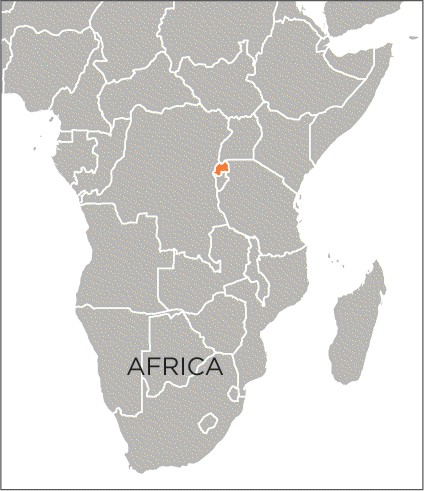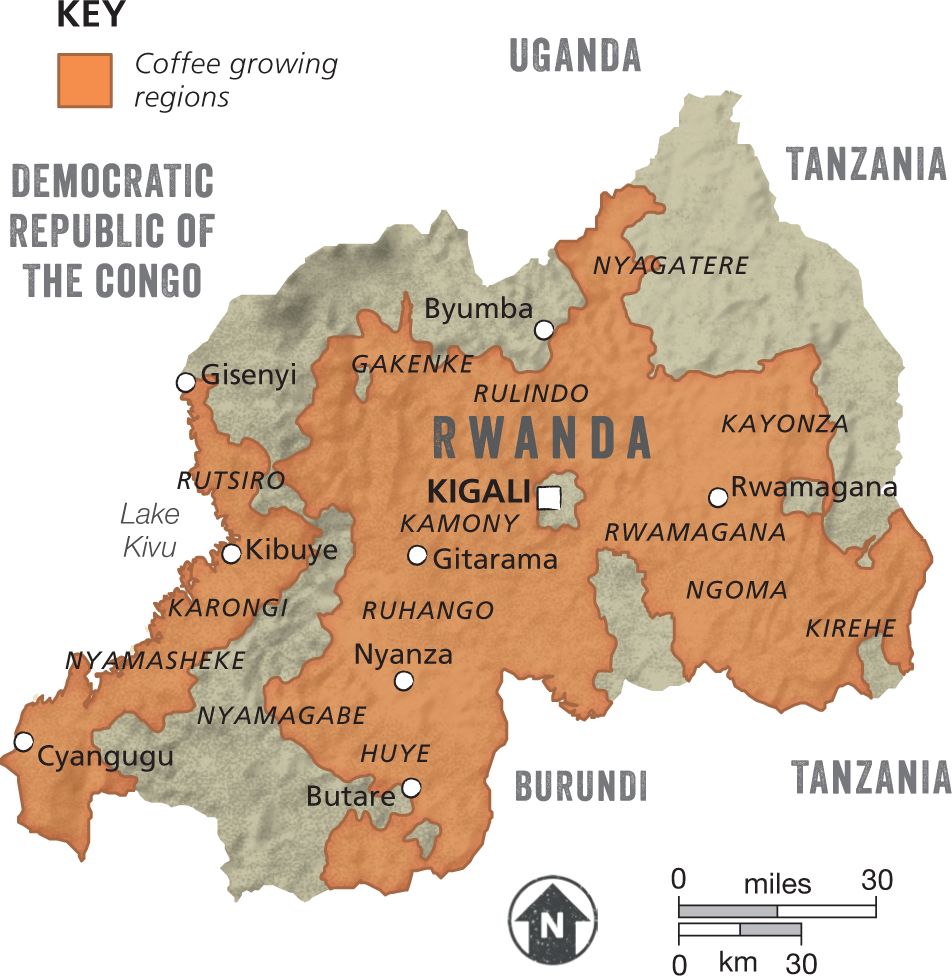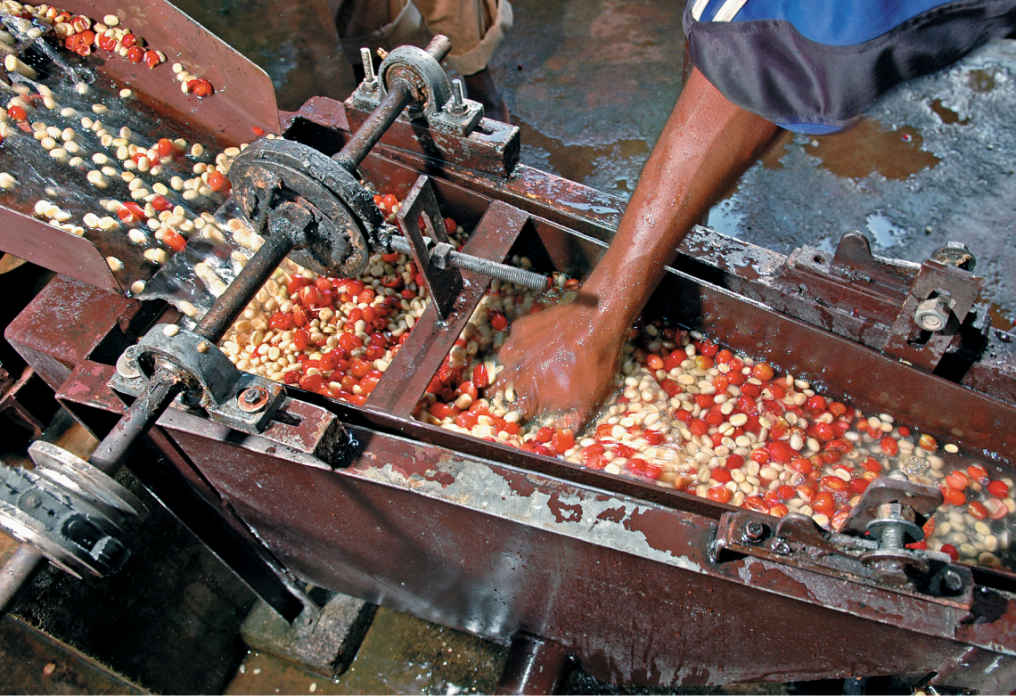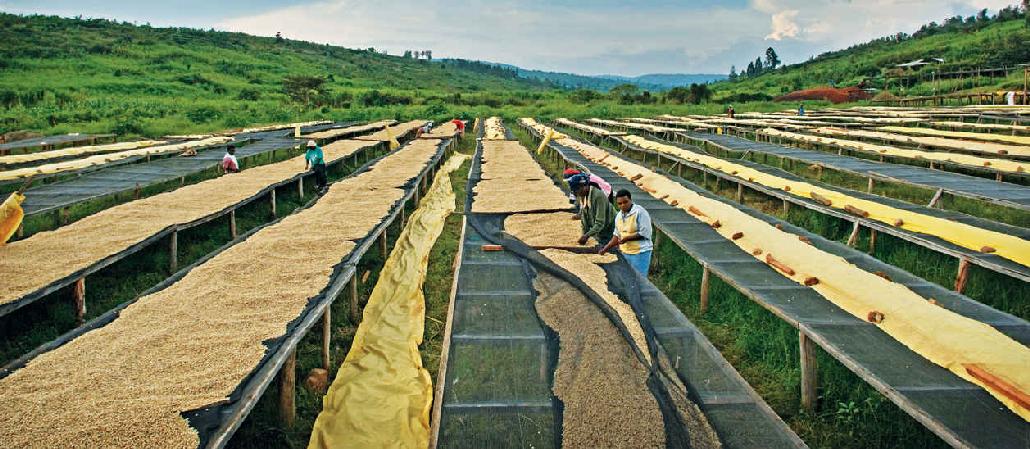German missionaries first brought coffee to Rwanda in 1904, but the country did not produce enough to begin exports until 1917. After World War I, the League of Nations Mandate stripped Germany of its colonial rule over Rwanda, and handed it to the Belgians. This is why, historically, most of Rwanda’s coffee has been exported to Belgium.

The first coffee trees were planted at the Mibirizi mission in Cyangugu province, and the place gives its name to the first Rwandan coffee variety, a natural mutation of Bourbon. Gradually coffee cultivation spread into the Kivu region and ultimately the rest of Rwanda. In the 1930s, coffee became a compulsory crop for many producers around the country, mirroring the Belgian colonial approach in neighbouring Burundi.
The Belgians strictly controlled exports and enforced high taxes on the growers. This pushed Rwanda towards producing high volumes of low-quality coffee, which sold for low prices. However, the fact that Rwanda exported so little gave coffee an oversized impact and a sense of importance for the farmers. There was little infrastructure to allow the production of quality coffee, not even a single washing station.
By the 1990s, coffee was Rwanda’s most valuable export, but the events of the decade would decimate the coffee industry. In 1994, the widespread genocide in the country claimed nearly one million lives, and had a massive impact on the coffee industry. This was compounded by worldwide coffee prices falling to a very low level.

COFFEE’S ROLE IN RWANDA’S RECOVERY
Coffee was to become a symbol of positivity as Rwanda got back on its feet following the genocide. As foreign aid and interest streamed into the country, there was a strong focus on the coffee sector. Washing stations were built and there was a determined drive towards producing higher-quality coffee. The government took a more open approach to the coffee trade, and speciality coffee buyers from around the world have shown a strong interest in the country’s coffees. Rwanda is the only African country to have hosted a Cup of Excellence competition, a project to find the very best lots and to bring them to market through an online auction system.
The first washing station was built in 2004 with assistance from the United States Agency for International Development (USAID). Many more followed and the number has grown dramatically in recent years with around three hundred in operation today. The PEARL project (Partnership for Enhancing Agriculture in Rwanda through Linkages) was successful in helping to spread knowledge and train young agronomists. It has since become the SPREAD project (Sustaining Partnerships to enhance Rural Enterprise and Agribusiness Development) and both projects have focused their efforts in the Butare region.
Rwanda is known as the ‘land of a thousand hills’ and certainly has the altitude and weather to grow great coffee. However, there is the problem of widespread soil depletion and transport still poses a challenge, often adding great expense to production costs.
When worldwide coffee prices increased around 2010, it was a challenge in Rwanda (and much of the rest of the world) to find suitable incentives to keep quality high. When the market pays high prices, there is little reason to spend money to increase quality, as even low-quality coffee is sufficiently profitable. However, recently the quality of Rwandan coffees has been excellent. Rwanda does grow and export a small amount of Robusta, but most of its output is fully washed Arabica.
 At a coffee washing station in Butare, a worker keeps the coffee cherries moving as the depulping machine separates the seeds from the fruit flesh.
At a coffee washing station in Butare, a worker keeps the coffee cherries moving as the depulping machine separates the seeds from the fruit flesh.
THE POTATO DEFECT
This is a particular and unusual defect found only in coffees from Burundi and Rwanda. It is caused by an unknown bacteria entering the cherry’s skin and producing an unpleasant toxin. It is not harmful to health, but when afflicted beans are roasted and ground they release an unmistakeable and pungent aroma that is eerily similar to the smell of peeling a raw potato. This defect affects only specific beans, so finding it in your coffee does not mean the whole bag is spoiled, unless it has all been ground.
Eradication is tricky. It is undetectable once post-harvest processing is finished, so a coffee roaster cannot do anything to detect it before roasting. Even after roasting it is difficult to discover until a bean with the defect is ground. It is possible to do some work during processing to identify the cherries that have had their skins broken and are likely to be tainted. Work is being done both on the ground and at research level to eradicate this particular defect.
 Workers spread the coffee out on drying tables, where it will dry out for five days, in preparation for roasting or export.
Workers spread the coffee out on drying tables, where it will dry out for five days, in preparation for roasting or export.
TRACEABILITY
Coffees in Rwanda tend to be traceable back to washing stations and the numerous farmer groups and cooperatives that supply them. Each producer has on average just 183 trees, so it is not possible to find a coffee traceable to a single producer.
LOCAL VARIETIES
MIBIRIZI
This is the name of the mission in Rwanda that received some Bourbon trees from Guatemala. Mibirizi is a natural variant of Bourbon, which appeared at the mission. It was initially grown in Rwanda and later spread to Burundi in the 1930s.
JACKSON
This is another Bourbon variant that was initially grown in Rwanda and has since spread to Burundi.
TASTE PROFILE
Amazing coffees from Rwanda often have a fruitiness and freshness reminiscent of red apples or red grapes. Berry fruit flavours and floral qualities are also fairly common.
GROWING REGIONS
Population: 11,920,000
Number of 60kg (132lb) bags in 2016: 220,000
Coffee is grown across the whole of Rwanda, without specific geographic zones of constriction. Roasters may use the name of a district along with the name of the washing station or farmer group.
SOUTHERN AND WESTERN REGION
Some stunning coffees come from this part of the country. Production seems particularly focused around the mountainous Huye region, the Nyamagabe region and the Nyamasheke region on the shores of Lake Kivu.
| Altitude: | 1,700–2,200m (5,600–7,200ft) |
| Harvest: | March–June |
| Varieties: | Bourbon, Mibirizi |
EASTERN REGION
The altitude in the east of the country is not as high as in other regions, but great coffees are being produced in Ngoma and in Nyagatare in the extreme northeast.
| Altitude: | 1,300–1,900m (4,300–6,200ft) |
| Harvest: | March–June |
| Varieties: | Bourbon, Mibirizi |